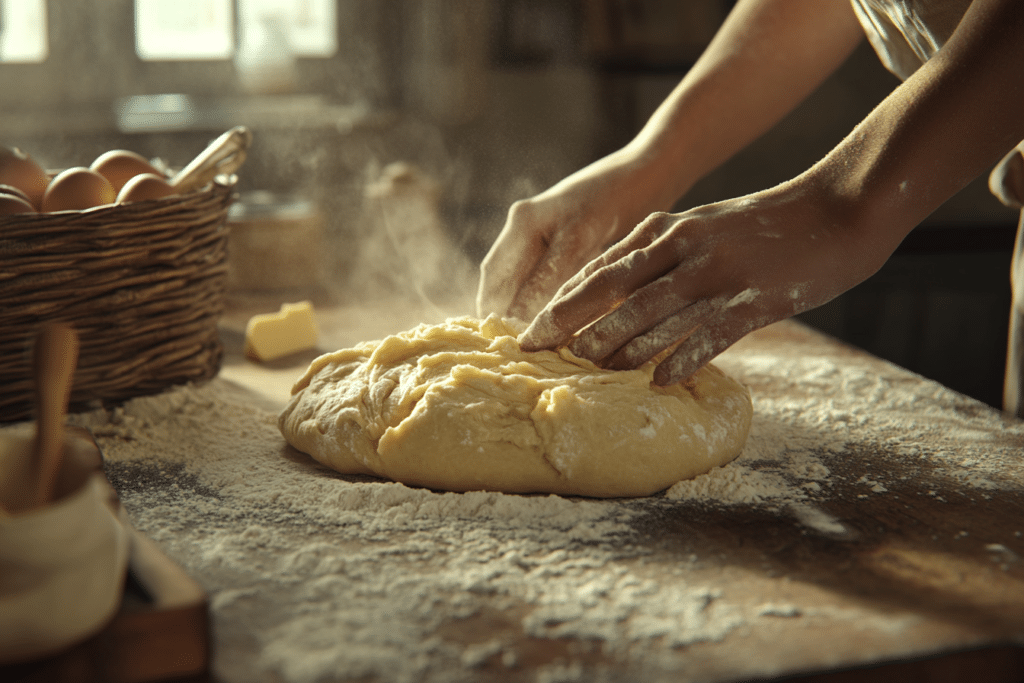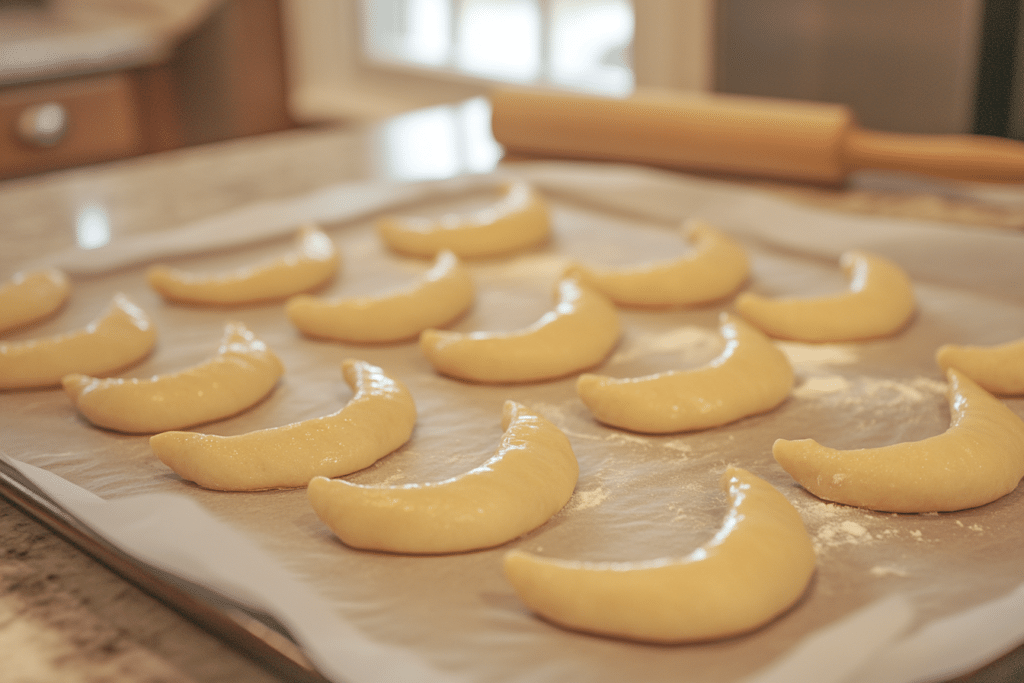1. Introduction to the Gipfeli Recipe
Gipfeli recipe is a term that captures the essence of creating Switzerland’s beloved pastry, often called the Swiss croissant. Gipfeli is a staple in Swiss breakfasts, known for its slightly denser texture and versatility in sweet and savory fillings. Known for its slightly denser texture compared to the French croissant, Gipfeli has carved a niche as a versatile treat, equally delightful with sweet or savory fillings.
In this article, we’ll explore the history, preparation techniques, and variations of Gipfeli recipes. Whether you’re a seasoned baker or a beginner, this guide will help you create this Swiss classic at home, from dough preparation to final bake.
2. What is Gipfeli?
2.1. Origin and History of the Gipfeli Recipe
Gipfeli has its roots deeply embedded in Swiss culture, where it’s a staple in bakeries and breakfast spreads. While it bears a resemblance to the French croissant, Gipfeli is distinct in its texture and taste. Unlike the croissant, which is renowned for its flaky layers, Gipfeli boasts a denser bite, making it perfect for pairing with robust Swiss coffee or hot chocolate.
Historically, Gipfeli evolved as a regional adaptation of the crescent-shaped pastries popularized across Europe. Its slightly sweeter dough and unique texture distinguish it from its French counterpart.
2.2. Unique Characteristics That Define a Great Gipfeli Recipe
Gipfeli sets itself apart from other pastries in several ways:
- Texture: While croissants are ultra-flaky, Gipfeli strikes a balance between fluffiness and density.
- Fillings: Popular variations include almond paste (Mandelgipfel), nut filling (Nussgipfel), and fruit preserves.
- Shape: The crescent shape is more compact, giving it a distinct Swiss identity.
The versatility of Gipfeli makes it a favorite for both sweet and savory applications, offering something for everyone.
3. IIngredients and Tools Needed for Making the Gipfeli Recipe
3.1. Essential Ingredients for an Authentic Gipfeli Recipe
To make authentic Gipfeli, you’ll need a handful of simple yet high-quality ingredients. These components ensure the dough achieves the perfect balance of flavor and texture.
- Flour: All-purpose flour works best, but bread flour can add a chewier texture.
- Sugar: For a touch of sweetness in the dough.
- Yeast: Active dry or fresh yeast helps the dough rise.
- Cold Butter: Key to achieving flaky layers during lamination.
- Eggs: Used in the dough and for the egg wash to create a golden crust.
- Milk: Adds richness to the dough and enhances the flavor.
- Salt: Balances the sweetness and adds depth to the pastry.
- Optional Fillings: Almond paste, nut mixtures, chocolate, or jam for customization.
3.2. Must-Have Tools to Perfect Your Gipfeli Recipe
Having the right tools will make the process smoother and more enjoyable:
- Rolling Pin: Essential for evenly rolling and laminating the dough.
- Pastry Brush: For applying egg wash.
- Baking Sheet: To hold the Gipfeli during proofing and baking.
- Stand Mixer: Useful for kneading the dough, especially if making a large batch.
- Sharp Knife or Pizza Cutter: For cutting dough triangles.
3.3. Tips for Ingredient Quality
Quality ingredients are the secret to a successful Gipfeli:
- Butter: Use European-style butter with a higher fat content for flakier layers.
- Yeast: Always ensure your yeast is fresh and active; expired yeast will result in flat pastries.
- Flour: Sift the flour to eliminate lumps and improve the dough texture.
4. Step-by-Step Guide to Making the Gipfeli Recipe
4.1. Preparing the Dough for the Gipfeli Recipe
The foundation of a perfect Gipfeli lies in its dough. Here’s how to get started:
- Activate the Yeast: In a small bowl, mix warm milk (110°F/45°C) with a teaspoon of sugar. Sprinkle yeast on top and let it sit for 5–10 minutes until frothy.
- Mix the Dough: In a stand mixer bowl, combine flour, remaining sugar, and salt. Add the yeast mixture, eggs, and softened butter. Mix until the dough comes together.
- Knead: Knead the dough for 8–10 minutes until smooth and elastic.
- Rest: Cover the dough with a damp cloth and let it rise for 1–2 hours in a warm place until it doubles in size.
4.2. Laminating Dough: The Key to Perfect Layers in Your Gipfeli Recipe
Laminating is the process of incorporating butter into the dough to create layers:

- Prepare Butter Block: Place cold butter between two sheets of parchment paper and flatten into a square using a rolling pin. Chill until firm but pliable.
- Roll Out Dough: Roll the dough into a rectangle twice the size of the butter block. Place the butter block in the center and fold the dough over it, sealing the edges.
- Create Layers: Roll out the dough and fold it into thirds (like a letter). Rotate 90 degrees and repeat the process 3–4 times, chilling the dough between folds.
Pro Tip: Keep the dough and butter cold throughout the process to prevent melting and ensure distinct layers. Laminating the dough is a critical step in achieving flaky layers. For a deeper understanding of the science behind laminated dough, visit The Science of Baking Laminated Dough.
4.3. Shaping and Filling: The Art of Crafting a Classic Gipfeli Recipe
Once laminated, it’s time to shape the Gipfeli:
- Cut Dough: Roll the dough into a large rectangle about 1/4-inch thick. Use a sharp knife or pizza cutter to divide the dough into long triangles.
- Add Fillings (Optional): Place almond paste, nut mixture, or jam at the wide end of each triangle.
- Roll: Starting at the wide end, roll the triangle tightly toward the tip to form the classic crescent shape.
4.4. Proofing and Baking the Perfect Gipfeli Recipe
The final steps bring the Gipfeli to life:
- Proof: Arrange the shaped pastries on a baking sheet, leaving space between them. Cover with a damp cloth and let rise for 30–45 minutes until puffy.
- Apply Egg Wash: Lightly brush the Gipfeli with a mixture of beaten egg and milk for a shiny, golden finish.
- Bake: Preheat the oven to 375°F (190°C). Bake for 15–20 minutes or until golden brown.
Enjoy your freshly baked Gipfeli warm or at room temperature!
5. Popular Variations of Gipfeli
5.1. Mandelgipfel (Almond Gipfeli)
A favorite among sweet pastry lovers, Mandelgipfel features a luscious almond filling.
- Ingredients for Filling: Almond paste, sugar, egg white, and a hint of almond extract.
- Instructions: Spread the almond paste mixture on the wide end of each triangle before rolling. Top the shaped Gipfeli with slivered almonds before baking.
5.2. Nussgipfel (Nut-Filled Gipfeli)
Nussgipfel is another iconic variation, filled with a sweet nut mixture.
- Ingredients for Filling: Ground hazelnuts or walnuts, sugar, heavy cream, and cinnamon.
- Instructions: Combine ingredients into a paste and add to the wide end of the dough triangles. Roll, shape, and bake as usual. For an extra touch, drizzle with a simple powdered sugar glaze after baking.
5.3. Jam-Filled Gipfeli
For a fruity twist, jam-filled Gipfeli are perfect for breakfast or a light snack.
- Ingredients: Apricot, raspberry, or strawberry preserves.
- Instructions: Place a dollop of jam on each triangle’s wide end. Be careful not to overfill to avoid leaks during baking.
Pro Tip: Chill the jam slightly to make it easier to handle when filling.
5.4. Savory Gipfeli
Savory versions of Gipfeli are equally popular, offering a satisfying snack or light meal.

- Filling Ideas: Cheese and ham, spinach and feta, or cream cheese with herbs.
- Instructions: Spread the savory filling on the wide end of the triangle, roll, and bake as usual. Serve warm for the best flavor.
Gipfeli, like cheese or ham-filled options, are perfect for snacks. For another savory delight, check out this Crab Brûlée Recipe.
6. Tips and Techniques for Perfect Gipfeli
6.1. Achieving Flaky Layers
The hallmark of a great Gipfeli lies in its delicate layers. Follow these tips for the flakiest results:
- Keep Ingredients Cold: Always chill the butter and dough during lamination to prevent the butter from melting into the dough.
- Roll Evenly: Use steady pressure when rolling the dough to maintain uniform layers.
- Don’t Overwork the Dough: Over-handling can warm the butter and compromise the pastry’s texture.
Pro Tip: Place the dough in the freezer for a few minutes if it becomes too soft while rolling.
6.2. Troubleshooting Common Issues
Even experienced bakers encounter challenges. Here’s how to solve some common problems:
- Butter Leakage: If butter seeps out during baking, it’s likely due to uneven folds or improper sealing. Ensure the edges are fully closed during lamination.
- Dense Texture: This can result from over-proofing or under-kneading. Knead the dough thoroughly and proof for the recommended time.
- Uneven Baking: Rotate the baking sheet halfway through the bake to ensure even browning.
6.3. Storing and Reheating Gipfeli
Gipfeli is best enjoyed fresh, but proper storage can keep them delicious for longer:
- Storing: Place cooled Gipfeli in an airtight container at room temperature for up to 2 days. For longer storage, freeze them in a sealed bag for up to a month.
- Reheating: To reheat, place in a preheated oven at 350°F (175°C) for 5–7 minutes to restore their crispiness.
Pro Tip: Avoid microwaving Gipfeli as it can make the pastry soggy.
7. Pairing Gipfeli with Beverages and Meals
7.1. Best Beverages to Pair with Gipfeli
The subtle sweetness and flaky texture of Gipfeli make them an excellent companion for various beverages. Popular pairings include:
- Coffee: A rich cappuccino or a creamy latte complements the buttery flavor of Gipfeli.
- Tea: Earl Grey or chamomile tea provides a refreshing balance to the pastry’s richness.
- Hot Chocolate: A favorite in Swiss cafes, the sweetness of hot chocolate enhances the flavors of both sweet and savory Gipfeli.
7.2. Incorporating Gipfeli into Meals
Gipfeli isn’t just a standalone pastry—it can be part of a larger meal:
- Breakfast Spread: Serve alongside fresh fruit, yogurt, and scrambled eggs for a complete morning feast.
- Dessert Platter: Pair sweet Gipfeli varieties with whipped cream, berries, and a dusting of powdered sugar for an elegant dessert.
- Savory Snacks: Enjoy savory Gipfeli with a side salad or soup for a light lunch.
The versatility of Gipfeli makes them suitable for any time of day, whether as a quick snack or the centerpiece of a gourmet meal.
8. Frequently Asked Questions (FAQs)
8.1. What is the Difference Between a Croissant and a Gipfeli?
While both are crescent-shaped pastries, Gipfeli is denser and less flaky than the French croissant. It also tends to have a slightly sweeter dough and can include a variety of fillings, making it more versatile for different tastes.
8.2. What is a Croissant Called in Switzerland?
In Switzerland, croissants are commonly referred to as “Gipfeli.” However, they differ from the traditional French croissant due to their texture and the regional adaptations in flavor and preparation.
8.3. What is a Nussgipfel?
A Nussgipfel is a variation of Gipfeli filled with a sweet nut mixture, typically made from ground hazelnuts or walnuts. It’s a favorite in Swiss bakeries and offers a rich, satisfying flavor.
8.4. How Long Does It Take to Make Gipfeli?
Making Gipfeli from scratch takes about 4–5 hours, including time for preparing, laminating, proofing, and baking the dough. The process is time-intensive but rewarding, resulting in fresh, homemade pastries.
9. Conclusion
Gipfeli, a beloved Swiss pastry, combines simplicity and versatility to create a treat that’s cherished by many. Whether you prefer it sweet with almond or jam fillings, or savory with cheese and ham, this pastry offers endless possibilities to suit your taste. With its slightly denser texture and rich flavor, Gipfeli stands out as a delightful alternative to the traditional croissant.
By following this guide, you can master the art of making Gipfeli at home. From selecting high-quality ingredients to mastering the lamination process, every step contributes to the perfect pastry. While it requires patience and precision, the reward of fresh, golden Gipfeli is well worth the effort.
Now it’s your turn to bring a touch of Switzerland into your kitchen. Try the recipes, experiment with variations, and enjoy the timeless joy of baking Gipfeli. Whether for breakfast, dessert, or a snack, this pastry is sure to impress.
